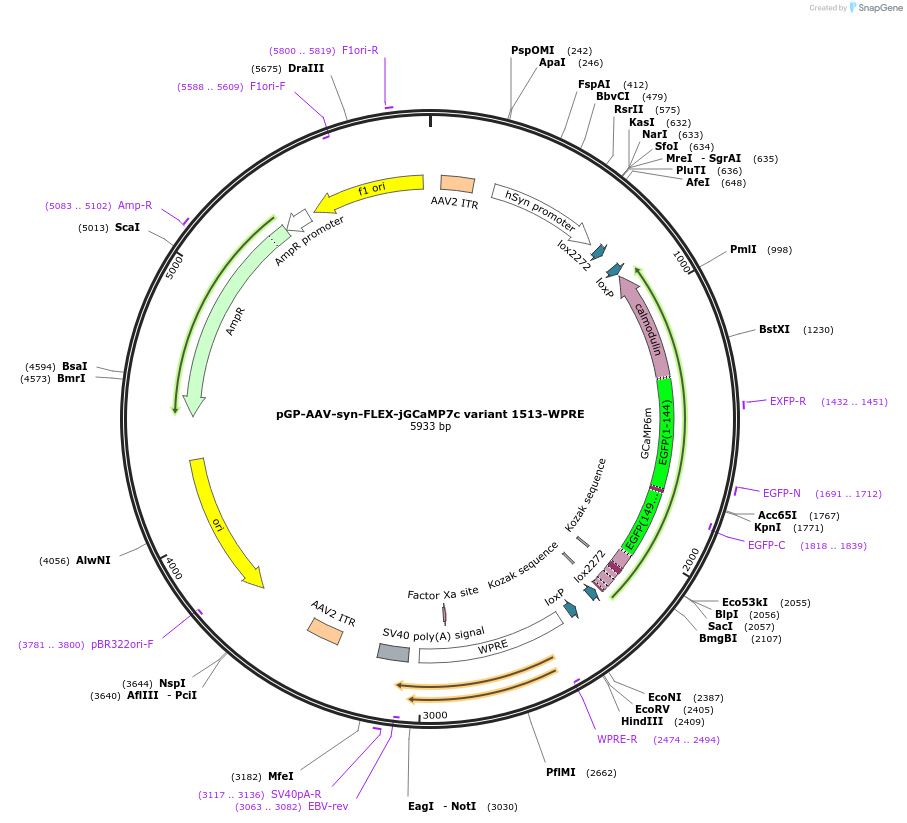pGP-AAV-syn-FLEX-jGCaMP7c variant 1513-WPRE
(Plasmid
#105322)
-
PurposeAAV-mediated expression of ultrasensitive protein calcium sensor under the Syn promoter, Cre-dependent expression
-
Depositing Labs
-
Sequence Information
Ordering
| Item | Catalog # | Description | Quantity | Price (USD) | |
|---|---|---|---|---|---|
| Plasmid | 105322 | Standard format: Plasmid sent in bacteria as agar stab | 1 | $89 | |
| AAV1 | 105322-AAV1 | 100 µL at titer ≥ 7×10¹² vg/mL and Plasmid. | $437 | ||
Don’t see the serotype you want?
Make a packaging request and we'll get back to you.
Please log in to submit a packaging request.
-
SerotypeSelect serotype for details See details about
-
PricingSelect serotype and quantity $ USD for preparation of µL virus + $32 USD for plasmid.
-
How this works
- Place a request for a quantity of 2 (0.2 mL), 10 (1 mL), 25 (2.5 mL), or 50 (5 mL). Our all-inclusive pricing includes DNA production and QC.
- Addgene will quickly confirm that we can produce a high-quality prep for you.
- Track your request and place an order from within your account. Payment information must be added before we can begin processing your order.
- Receive your prep in 6–9 weeks after the MTA is approved by your organization.
- Learn more about our Packaged on Request Service.
Backbone
-
Vector backboneAAV-Syn-FLEX
-
Backbone manufacturerScott Sternson
- Backbone size w/o insert (bp) 4894
- Total vector size (bp) 6247
-
Vector typeMammalian Expression, AAV, Cre/Lox
Growth in Bacteria
-
Bacterial Resistance(s)Ampicillin, 100 μg/mL
-
Growth Temperature30°C
-
Growth Strain(s)NEB Stable
-
Copy numberLow Copy
Gene/Insert
-
Gene/Insert namejGCaMP7c variant 1513
-
Alt nameGCaMP3-L59Q E60P T302L R303P M378G K379S D380Y T381R R392G T412N
-
Alt nameGCaMP3 variant 1513
-
Alt nameJanelia GCaMP7
-
SpeciesR. norvegicus (rat), G. gallus (chicken); A. victoria (jellyfish)
-
Insert Size (bp)1353
- Promoter Synapsin
-
Tag
/ Fusion Protein
- T7 epitope, Xpress tag, 6xHis
Cloning Information
- Cloning method Restriction Enzyme
- 5′ cloning site BsmBI (destroyed during cloning)
- 3′ cloning site BsmBI (destroyed during cloning)
- 5′ sequencing primer ACCACGCGAGGCGCGAGATAG
- (Common Sequencing Primers)
Resource Information
-
Article Citing this Plasmid
Terms and Licenses
-
Academic/Nonprofit Terms
-
Industry Terms
- Not Available to Industry
Trademarks:
- Zeocin® is an InvivoGen trademark.
Information for AAV1 (Catalog # 105322-AAV1) ( Back to top)
Purpose
Ready-to-use AAV1 particles produced from pGP-AAV-syn-FLEX-jGCaMP7c variant 1513-WPRE (#105322). In addition to the viral particles, you will also receive purified pGP-AAV-syn-FLEX-jGCaMP7c variant 1513-WPRE plasmid DNA.
Synapsin-driven, Cre-dependent jGCaMP7c expression. jGCaMP7c exhibits high contrast between peak fluorescence and resting fluorescence. It is useful for activity imaging of large populations of densely-labeled neurons because background fluorescence from inactive neurons is reduced. These AAV preparations are suitable purity for injection into animals.Delivery
- Volume 100 µL
- Titer ≥ 7×10¹² vg/mL
- Pricing $405 USD for preparation of 100 µL virus + $32 USD for plasmid.
- Storage Store at -80℃. Thaw just before use and keep on ice.
- Shipment Viral particles are shipped frozen on dry ice. Plasmid DNA (≥ 200ng) will also be included in the shipment.
Viral Production & Use
- Packaging Plasmids encode adenoviral helper sequences and AAV rep gene, AAV1 cap gene
- Buffer PBS + 0.001% Poloxamer 188 + 200 mM NaCl
- Serotype AAV1
- Purification Iodixanol gradient ultracentrifugation
Biosafety
Requestor is responsible for compliance with their institution's biosafety regulations. Lentivirus is generally considered BSL-2. AAV is generally considered BSL-1, but may require BSL-2 handling depending on the insert. Biosafety Guide
Terms and Licenses
-
Academic/Nonprofit Terms
-
Industry Terms
- Not Available to Industry
Viral Quality Control
- Addgene ensures high quality viral vectors by optimizing and standardizing production protocols and performing rigorous quality control (QC) (see a list of our QC assays). The specific QC assays performed varies for each viral lot. To learn which specific QC assays were performed on your lot, please contact us.
- Titer: the exact titer of your sample will be reported on the tube. The titer you see listed on this page is the guaranteed minimum titer. See how titers are measured.
Visit our viral production page for more information.
Addgene Comments
Using FLEX vectors in vivo: LoxP sites in FLEX plasmids are known to recombine during DNA amplification and viral vector production, which may result in a minority of Cre-activated (i.e., "flipped") viral vectors. Addgene has measured this occurs in 0.1-0.8% of viral particles in our typical production protocol. This can lead to a small number of cells exhibiting Cre-independent transgene expression in vivo. To address this, it is necessary to optimize the injection volume and viral titer to find the optimal AAV dosage required for Cre-dependent transgene expression and function in vivo. This may include reducing the viral particle dosage in order to reduce the likelihood of Cre-independent expression.
These plasmids were created by your colleagues. Please acknowledge the Principal Investigator, cite the article in which the plasmids were described, and include Addgene in the Materials and Methods of your future publications.
-
For your Materials & Methods section:
pGP-AAV-syn-FLEX-jGCaMP7c variant 1513-WPRE was a gift from Douglas Kim & GENIE Project (Addgene plasmid # 105322 ; http://n2t.net/addgene:105322 ; RRID:Addgene_105322) For viral preps, please replace (Addgene plasmid # 105322) in the above sentence with: (Addgene viral prep # 105322-AAV1) -
For your References section:
High-performance calcium sensors for imaging activity in neuronal populations and microcompartments. Dana H, Sun Y, Mohar B, Hulse BK, Kerlin AM, Hasseman JP, Tsegaye G, Tsang A, Wong A, Patel R, Macklin JJ, Chen Y, Konnerth A, Jayaraman V, Looger LL, Schreiter ER, Svoboda K, Kim DS. Nat Methods. 2019 Jul;16(7):649-657. doi: 10.1038/s41592-019-0435-6. Epub 2019 Jun 17. 10.1038/s41592-019-0435-6 PubMed 31209382




